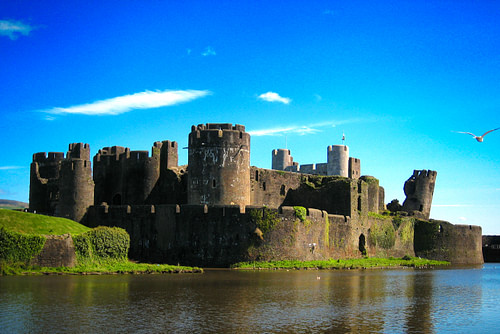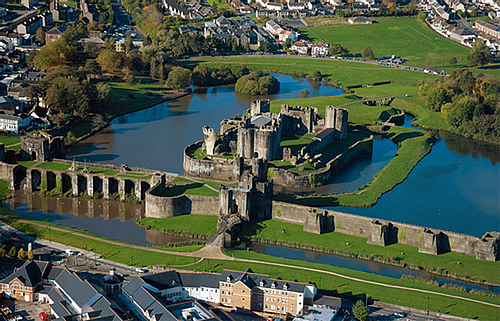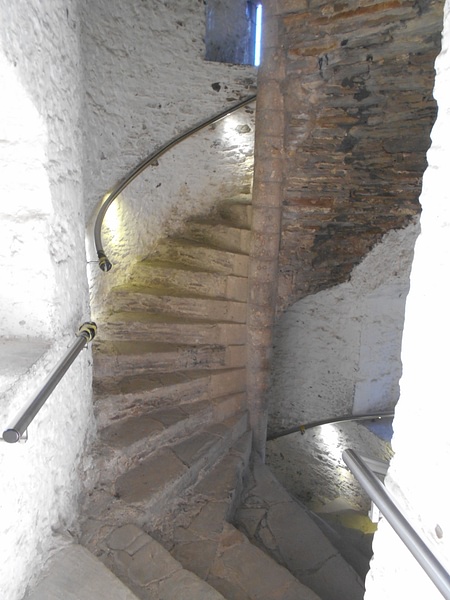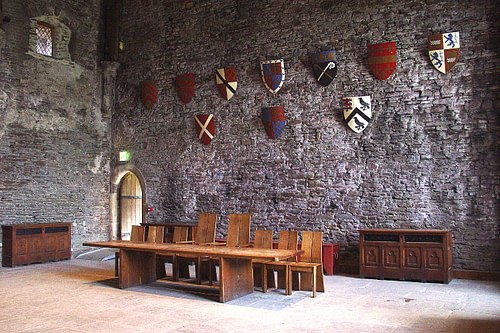Caerphilly Castle

Caerphilly Castle
Caerphilly Castle (aka Caerffili), located in South Wales, was first built between 1268 and 1290 CE. The largest medieval castle in Wales, Caerphilly was built with a concentric design by Gilbert de Clare (1243-1295 CE) as a robust defence against Welsh attacks. Restored in the first half of the 20th century CE by the Marquess of Bute, it is famous for its artificial water defences which now make for a picturesque foreground to the mighty round towers and fortified gatehouses of the second largest castle in England and Wales at the time of building. Today, the castle is managed by Cadw and is open to visitors.
The Conquest of Wales
Henry III of England (r. 1216-1272 CE) had attempted to conquer parts of Wales but he suffered a string of military defeats there (1228, 1231, and 1232 CE), which led to Henry conferring on the Welsh leader Llywelyn ap Gruffudd (c. 1223-1282 CE) the title of Prince of Wales. The project was not abandoned, though, and so Caerphilly Castle was built from 1268 CE by the English noble Earl Gilbert de Clare, a Marcher Lord, holder of several titles including the Earl of Gloucester, and one of the richest men in England. The castle was designed to command the strategically important point where the Rhymney valley starts to open out into the plain.
EARL DE CLARE ENSURED CAERPHILLY WAS THE LARGEST, STRONGEST & MOST IMPOSING CASTLE IN WALES.
The first main building phase was not completed until 1277 CE, and then a second phase continued until 1290 CE. The principal threat to de Clare's occupation of the area remained Llywelyn ap Gruffudd. The fact that the castle was sorely needed is evidenced by the two attacks upon it by the Welsh prince before it had even been finished. Nevertheless, Earl de Clare was certainly ambitious and he ensured Caerphilly was the largest, strongest and most imposing castle in Wales, indeed the only castle in Britain bigger was Windsor Castle.

Caerphilly Castle Aerial View
Edward I of England (r. 1272-1307 CE) was much more competent and ambitious than his father Henry III, and he set out to conquer the Welsh once and for all. Organising a massive army in 1276 CE, the English king marched into Wales and stripped Llywelyn of his lands, although he did permit him to keep his now-meaningless royal title. Nevertheless, the Welsh still had ambitions of freedom from English rule and Llywelyn's brother Dafydd stirred up yet another rebellion. The rebels were defeated and Llywelyn was killed in 1282 CE, his head presented to the English king in triumph and then displayed at the Tower of London. Dafydd was eventually captured and executed, too.
CAERPHILLY TOOK ON A NEW ROLE AS A SPLENDID RESIDENCE WITH A HUNTING PARK & LAKE.
There would be one more Welsh rebellion, this time led by Madog ap Llywelyn in 1294 CE, but it was quashed the next year and Wales was then administered as if it were a part of England. While Edward I built a string of new castles in troublesome North Wales such as Caernarfon Castle, Conwy Castle and Harlech Castle, the castle at Caerphilly was no longer needed as a defensive structure. Accordingly, Caerphilly took on a new role as a splendid residence with a hunting park and lake. The castle came under the ownership of Hugh le Despenser, a favourite of Edward II of England (r. 1307-1327 CE) who had married Eleanor de Clare, a descendant of the castle's original owner. Despenser was responsible for redecorating the Great Hall into a much more opulent setting for holding audiences and banquets. The roof was raised and ornately carved doors and windows were added. The hall would have been put to good use when, in 1326 CE, Edward II fled to the castle to escape the clutches of his unfaithful wife Isabella of France (b. c. 1289 CE) and would-be usurper Roger Mortimer (1287-1330 CE).
Architectural Features
Caerphilly Castle is a massive example of a concentric castle with its double ring of fortification walls, each studded with round towers, square towers and four fortified gates. It was the first concentric castle built from scratch in Britain (other earlier ones such as Dover Castle were adaptations of existing structures). The design was likely inspired by French castles and Gilbert de Clare's practical experience at the siege of Kenilworth Castle in 1266 CE. There are no surviving financial records for the castle but because of the large quantity of sandstone used and its complex water defences, it must have cost more to build than many other major castles built in Wales in the 13th century CE.
The outer wall of Caerphilly was protected by a moat and the inner heart of the castle was built upon a small island set in a lake formed by damming the nearby river. The whole complex covers some 30 acres, and its water defences meant that it was immune to both tunnelling and siege engines. The two main gatehouses are located on the east and west sides of the castle. These structures were so well-built and protected by their double towers that they contained the finest chambers in the whole castle. It is likely that the constable of the castle had his residence in the upper stories of the east gatehouse where there are the remains of a great fireplace.
In addition to the towered-walls, the eastern and most exposed side of the castle received the extra protection of a long wall. This wall additionally enclosed a barbican or fortification to protect a fifth gatehouse. This gatehouse was connected to the main castle only by a narrow drawbridge which crossed a moat created by the lake. Here, too, was a watermill to provide the castle with flour.

Vice or Spiral Staircase, Caerphilly Castle
The drawbridge of the main gatehouse was pulled vertically closed using chains and holes for these can still be seen in the gateway above the entrance portal which had the usual extra protection of a portcullis. The presence of a second drawbridge, this time of the horizontal swing type, is evidenced by the surviving pit inside the gate's passageway. The passageway also had two rows of murder holes in the ceiling through which defenders could drop nasty things on any attackers. Finally, the gatehouse has a slanted chute just above the gate so that water could be poured down it to drench any attempt attackers might make to set fire to the closed drawbridge and portcullis.
Proceeding through the main East Gate the visitor then must pass through the inner east gatehouse which has a massive circular tower on either side. The more or less square inner ward or bailey is enclosed by walls with a large circular tower at each corner. The upper floors of these towers were accessed via spiral staircases or vices and the tops have crenellations. Directly opposite the east gate is the inner west gatehouse and on the left stands the Great Hall, built against the south wall. On the outer stretch of this wall, outside the bailey, is an additional semicircular tower. The castle's well, crucial in times of siege, is located in the inner bailey.

Great Hall, Caerphilly Castle
The Castle Today
Caerphilly Castle fell into disrepair, but during the 16th century CE, its round towers were still in a good enough state to act as a prison. The castle was finally restored from 1928 CE thanks to the efforts of the fourth Marquess of Bute. Lasting until 1939 CE, the costly effort to rebuild the collapsed and ruined medieval parts of the castle was the largest such project in Britain. The moats were dredged, main towers and gatehouses restored, and the bridges rebuilt. Later in the 20th century CE, the dams were repaired and the lake reflooded. The Great Hall has been fully restored and now, with its fine restored windows, it hosts the occasional wedding amongst other events. Today, the southeast tower of the castle has a definite lean, and this was caused by the storage of too many heavy gunpowder casks there during the English Civil War (1642-1651 CE).
The castle is open to the public and managed by Cadw, the Historic Environment department of the Welsh Assembly Government. Conservation work is ongoing and there are currently plans to build a new bridge from the western island across the moat using local Welsh oak. Besides the attraction of the castle itself, the site hosts reenactments of medieval tournaments and has several working replica siege engines.
Bibliography
Cadw: Caerphilly CastleAccessed 10 Mar 2020.
Gies, Joseph. Life in a Medieval Castle. Harper Perennial, 2015.
Phillips, Charles. The Medieval Castle Manual. Haynes Publishing UK, 2018.
Pounds, Norman J. G. The Medieval Castle in England and Wales. Cambridge University Press, 1993.
Translations
We want people all over the world to learn about history. Help us and translate this definition into another language!
About the Author
Mark Cartwright
Mark is a history writer based in Italy. His special interests include pottery, architecture, world mythology and discovering the ideas that all civilizations share in common. He holds an MA in Political Philosophy and is the Publishing Director at WHE.
https://www.worldhistory.org/Caerphilly_Castle/

